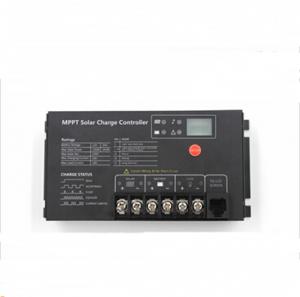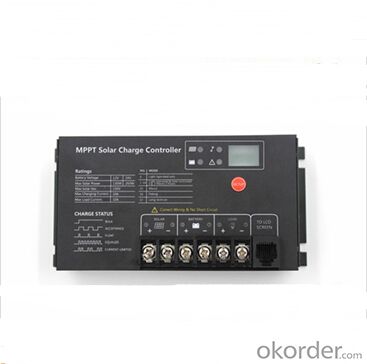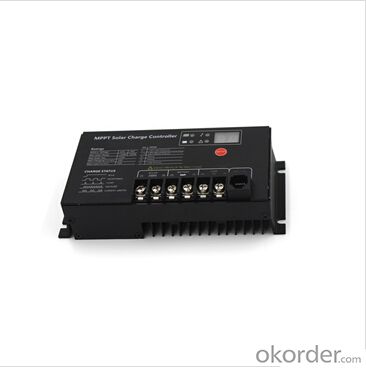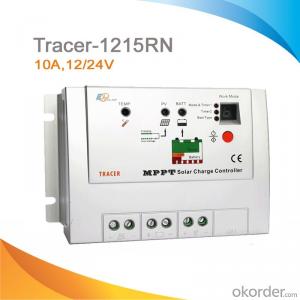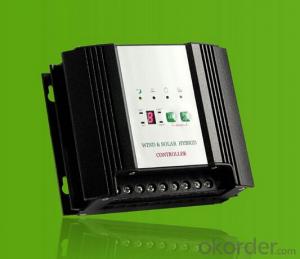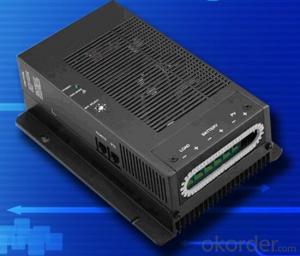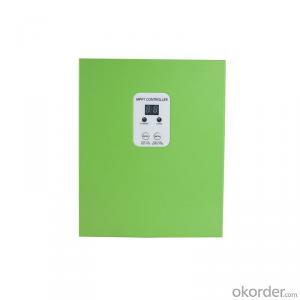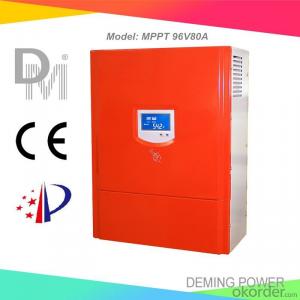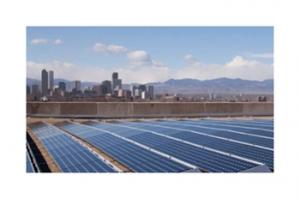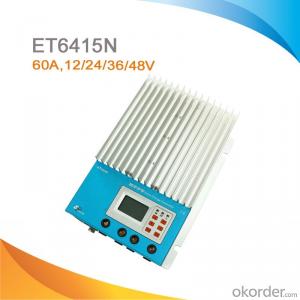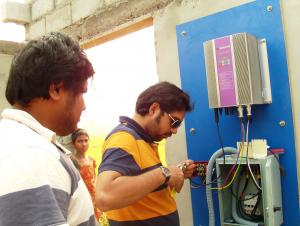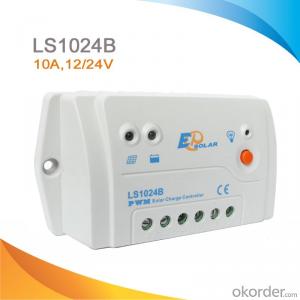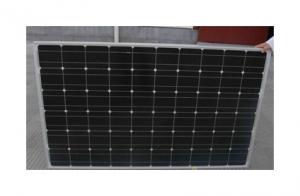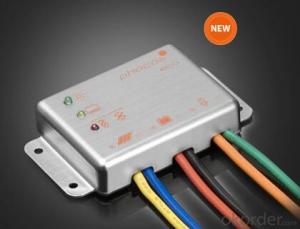Sunsaver Solar Controllers - Energy System Controllers 10A MPPT -12V/24V SR-MT
- Loading Port:
- China Main Port
- Payment Terms:
- TT or LC
- Min Order Qty:
- -
- Supply Capability:
- 10000 unit/month
OKorder Service Pledge
OKorder Financial Service
You Might Also Like
Features:
1. Mini size, high power density.
2. Various load control methods.
3. IP65 waterproof degree, metal shell.
4. Various system protection function.
5. Suitable use for home system and LED light.
6. The MPPT efficiency could reach up to 99.95%.
7. The energy conversion efficiency reach up to 97%.
8. The charging efficiency is 15%~20% higher than PWM mode.
9. With temperature compensation function to improve the life of the battery
10. Four stage charging mode:MPPT-equalizing charge-ascending charge-floating charge.
Electronic Protections:
·PV array short circuit
·Over discharging
·Over charging
·Load overload
·Load short circuit
·PV reverse polarity
·Battery reverse polarity
Name | Value |
System voltage | 12V/24V Auto |
Rated Load current | 10A |
Rated charging current | 10A |
Max input power(PV) | 130W/12V; 260W/24V |
No load loss | <10mA |
Solar input voltage | < 55V |
Transfer efficiency | ≤97% |
MPPT tracking efficiency | >99.92% |
Over voltage protection | 16.5V;×2/24V |
Charging limited voltage | 15.5V;×2/24V |
Equalizing charging voltage | 15.2V;×2/24V(25°C) |
Equalizing charging interval | 30 days |
Boost charging voltage | 14.4V;×2/24V(25°C) |
Float charging voltage | 13.8V;×2/24V(25°C) |
Return voltage for over-discharging | 12.5V;×2/24V |
over-discharging voltage | 11.0V;×2/24V |
Boost voltage charging time | 2hous |
Equalizing voltage charging time | 1hour |
Temperature compensation | -4.0mv/°C/2V; |
Over Temperature protection | 80°C |
Light-control open voltage | 5V |
Light-control close voltage | 6V |
Lighting control delay | 5min |
Working temperature | -35°C~ +65°C; |
Waterproof degree | IP65 |
Weight | 380g |
Dimensions | 143×71× 36(mm)(L×W×H) |
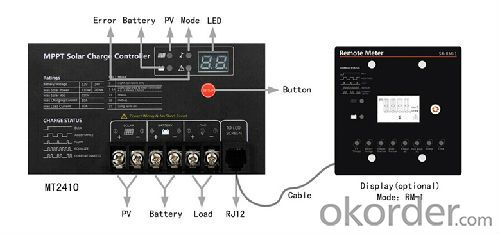
Warrenty
provides a 1~3 year limited warranty (“Warranty”) against defects in materials
and workmanship for its Uninterruptible power supply, Power inverter/chargers,
Solar charge controllers, Battery Products (“Product”).
The term of this Warranty begins on the Product(s) initial purchase date,
or the date of receipt of the Product(s) by the end user, whichever is later.
This must be indicated on the invoice, bill of sale, and/or warranty registration
card submitted to MUST-Solar. This Warranty applies to the original MUST-Solar Product purchaser,
and is transferable only if the Product remains installed in the original use location.
FAQ:
Q1. What is the voltage?
A1. Our 45/60A solar charge controller is 12/24/36/48V auto work.
Q2. What is the difference between MPPT&PWM?
A2. MPPT has higher efficiency, it can track the max power point and won't waste energy.
Q3. What is the efficiency of the MPPT controller?
A3. MPPT>99%, peak conversion efficiency>98%.
- Q: Can a solar controller be used with a solar-powered recycling bin?
- Yes, a solar controller can be used with a solar-powered recycling bin. A solar controller regulates the flow of energy from the solar panels to the recycling bin's battery, ensuring proper charging and preventing overcharging. It helps optimize the performance and efficiency of the solar-powered recycling bin by managing the power input and output.
- Q: Can a solar controller be used with a battery bank that is being charged from other sources (e.g., grid, generator)?
- Yes, a solar controller can be used with a battery bank that is being charged from other sources such as the grid or a generator. The solar controller will regulate the charging process and ensure that the battery bank is charged safely and efficiently, regardless of the source of power.
- Q: Can a solar controller be used with a solar-powered boat?
- Yes, a solar controller can be used with a solar-powered boat. A solar controller is a device that regulates the flow of electricity from the solar panels to the battery, ensuring efficient charging and preventing overcharging. Since solar-powered boats rely on solar panels to generate electricity, a solar controller is necessary to manage the power flow and protect the battery, making it an essential component for the boat's electrical system.
- Q: Can a solar controller be used with a solar-powered ventilation system?
- Yes, a solar controller can be used with a solar-powered ventilation system. A solar controller is designed to regulate and optimize the charging and discharging of solar panels, and it can also control the output of a solar-powered ventilation system. By connecting the solar controller between the solar panels and the ventilation system, it ensures that the system operates efficiently and effectively, maximizing the use of solar energy.
- Q: Can a solar controller be used with any type of solar panel?
- Yes, a solar controller can be used with any type of solar panel as long as the voltage and current specifications of the solar panel are within the range supported by the controller. The controller regulates the charging process and ensures optimal power transfer between the solar panel and the battery, regardless of the panel's technology or design.
- Q: Can a solar controller be used with a solar-powered retail store?
- Yes, a solar controller can be used with a solar-powered retail store. A solar controller is a device that regulates the flow of electricity from the solar panels to the batteries or grid. It helps optimize the charging process and protects the batteries from overcharging. In a solar-powered retail store, a solar controller would be essential to efficiently manage the power generated by the solar panels and ensure a stable and reliable energy supply for the store's operations.
- Q: What is the maximum charging time a solar controller can handle?
- The maximum charging time a solar controller can handle depends on various factors such as the capacity of the solar panels, the battery capacity, and the charging efficiency. However, generally speaking, solar controllers are designed to handle continuous charging for extended periods of time without any issues.
- Q: How do I calculate the maximum load output current for a solar controller in a grid-tied system?
- To calculate the maximum load output current for a solar controller in a grid-tied system, you need to consider a few factors. First, you need to determine the maximum power output of your solar panels. This information is usually provided by the manufacturer and can be found in the panel specifications. Let's assume your solar panels have a maximum power output of 300 watts. Next, you need to determine the voltage of your grid-tied system. This is typically the standard voltage of your country's electrical grid, such as 120 volts or 240 volts. To calculate the maximum load output current, you can use the formula: Maximum Load Output Current = Maximum Power Output / Voltage For example, if your solar panels have a maximum power output of 300 watts and your grid-tied system operates at a voltage of 240 volts, the calculation would be: Maximum Load Output Current = 300 watts / 240 volts = 1.25 amps Therefore, the maximum load output current for your solar controller in a grid-tied system would be 1.25 amps. It's important to note that this calculation assumes ideal conditions and does not take into account any losses or inefficiencies in the system. It's always recommended to consult the manufacturer's specifications and guidelines for your specific solar controller to ensure accurate calculations and safe operation.
- Q: What is the maximum temperature range a solar controller can operate in?
- The maximum temperature range a solar controller can typically operate in is between -40 degrees Celsius to 85 degrees Celsius.
- Q: Can a solar controller be used in marine applications?
- Yes, a solar controller can be used in marine applications. A solar controller, also known as a charge controller, is a device used to regulate the flow of electricity from solar panels to batteries. It ensures that the batteries are charged efficiently and prevents overcharging, which can damage the batteries. Marine applications often require a reliable and efficient power source, especially for boats or yachts that are frequently out at sea. Solar panels can be a great alternative to traditional power sources such as generators or shore power, as they harness the sun's energy to generate electricity. A solar controller is essential in marine applications to ensure that the batteries are charged properly and that the solar panels are functioning optimally. It also protects the batteries from overcharging, which can lead to reduced battery life and potential safety hazards. Furthermore, modern solar controllers are designed to withstand the harsh marine environment, including exposure to saltwater, humidity, and vibrations. They are typically made with corrosion-resistant materials and have waterproof or weatherproof ratings. In summary, a solar controller can be safely and effectively used in marine applications, providing a reliable and eco-friendly power source for boats, yachts, or other marine vessels.
Send your message to us
Sunsaver Solar Controllers - Energy System Controllers 10A MPPT -12V/24V SR-MT
- Loading Port:
- China Main Port
- Payment Terms:
- TT or LC
- Min Order Qty:
- -
- Supply Capability:
- 10000 unit/month
OKorder Service Pledge
OKorder Financial Service
Similar products
Hot products
Hot Searches
Related keywords
